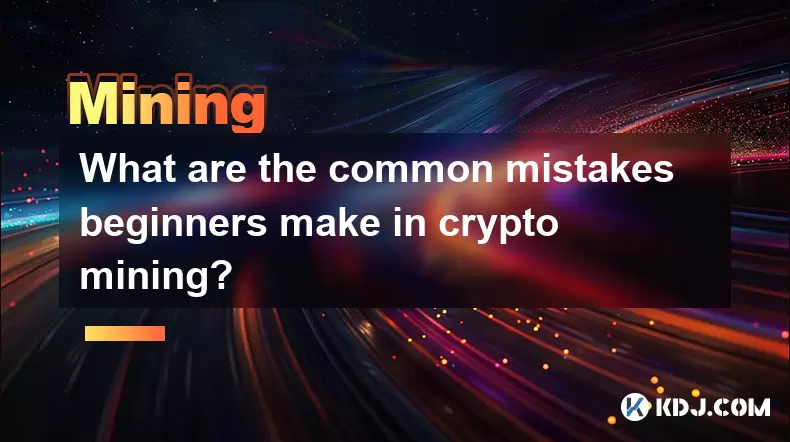-
 bitcoin
bitcoin $114320.977035 USD
-0.40% -
 ethereum
ethereum $4152.439985 USD
-1.75% -
 tether
tether $1.000111 USD
-0.04% -
 xrp
xrp $2.843037 USD
-1.63% -
 bnb
bnb $1013.349380 USD
-1.62% -
 solana
solana $208.362767 USD
-2.10% -
 usd-coin
usd-coin $0.999783 USD
0.00% -
 dogecoin
dogecoin $0.232559 USD
-1.00% -
 tron
tron $0.333491 USD
-1.09% -
 cardano
cardano $0.806310 USD
0.19% -
 hyperliquid
hyperliquid $45.023720 USD
-1.59% -
 ethena-usde
ethena-usde $1.000819 USD
-0.06% -
 chainlink
chainlink $21.241249 USD
-2.11% -
 avalanche
avalanche $30.035416 USD
-0.66% -
 stellar
stellar $0.364984 USD
-2.05%
What are the common mistakes beginners make in crypto mining?
Choosing the right mining hardware requires research into hash rate, power use, and costs—otherwise, high electricity or inefficient gear can lead to losses.
Aug 10, 2025 at 12:01 am

Choosing the Wrong Hardware Without Research
One of the most frequent errors new miners commit is purchasing mining hardware without conducting thorough research. Many beginners assume that any powerful graphics card or ASIC miner will automatically yield profits. This misconception leads to overspending on outdated or inefficient equipment. It is essential to verify the hash rate, power consumption, and current market value of the mining device before making a purchase. For example, an ASIC miner like the Antminer S19 Pro offers high efficiency, but its cost may not be justified for small-scale operations. Always calculate the break-even point using online mining calculators that factor in electricity rates, hardware cost, and network difficulty. Neglecting this step often results in negative returns, especially when energy costs exceed mining rewards.
Ignoring Electricity Costs and Location Impact
Electricity is the largest ongoing expense in crypto mining, yet many beginners overlook its impact on profitability. Miners in regions with high kWh rates may spend more on power than they earn in block rewards. For instance, if electricity costs $0.15 per kWh and the miner consumes 3,250 watts, the daily power expense alone can exceed $11, drastically reducing net gains. Selecting a location with access to low-cost or renewable energy is a critical strategic decision. Some miners relocate to countries or states with subsidized electricity or cooler climates to reduce cooling costs. Failing to account for these variables leads to unsustainable operations. Always use a detailed power cost estimator and compare it against projected mining income before setting up a rig.
Misconfiguring Mining Software and Pools
Improper setup of mining software is a technical pitfall that hampers efficiency. Beginners often download mining applications without understanding configuration files or pool settings. Using default settings can result in rejected shares, reduced hashrate, or complete failure to connect to a mining pool. To avoid this, follow these steps carefully:
- Download the correct mining software compatible with your hardware (e.g., CGMiner for ASICs, PhoenixMiner for GPUs).
- Register with a reputable mining pool such as F2Pool, Slush Pool, or Poolin.
- Obtain your wallet address and worker credentials from the pool dashboard.
- Edit the configuration batch file (.bat) to include pool URL, port, wallet address, and worker name.
- Test the connection in a command-line interface to ensure stable communication.Incorrect syntax in the config file—such as a typo in the wallet address—can redirect earnings to an invalid destination, resulting in permanent loss of mined coins.
Underestimating Heat, Ventilation, and Cooling Needs
Mining rigs generate substantial heat, and inadequate cooling leads to hardware degradation or failure. Many beginners place multiple GPUs or ASICs in enclosed spaces without proper airflow, causing temperatures to exceed safe thresholds. Overheating reduces mining efficiency and shortens the lifespan of components. To maintain optimal conditions: - Install mining rigs in well-ventilated areas, preferably with active exhaust fans.
- Use temperature monitoring tools like HWInfo or MSI Afterburner to track GPU and ASIC thermals.
- Keep ambient room temperature below 25°C (77°F) to prevent thermal throttling.
- Consider building a dedicated mining rack with spaced-out hardware to avoid heat stacking.Ignoring thermal management can result in automatic shutdowns or permanent damage, which interrupts mining and increases downtime.
Failing to Secure Wallets and Private Keys
After successfully mining cryptocurrency, many newcomers neglect secure storage practices. Storing mined coins on exchange wallets or unencrypted software wallets exposes them to hacking and theft. Hardware wallets like Ledger or Trezor offer offline (cold) storage, significantly reducing vulnerability. Steps to ensure fund security include: - Generate a new wallet address specifically for mining payouts.
- Enable two-factor authentication (2FA) on all associated accounts.
- Write down the recovery seed phrase and store it in a fireproof, offline location.
- Avoid sharing worker login details or API keys with third-party services.Losing access to private keys means losing access to all mined assets permanently, a risk that cannot be reversed.
Neglecting Regular Maintenance and Firmware Updates
Mining hardware requires ongoing maintenance to operate efficiently. Dust accumulation, outdated firmware, and unstable power supplies degrade performance over time. Beginners often set up their rigs and assume they will run indefinitely without intervention. To prevent avoidable failures: - Clean air filters and heatsinks every two weeks using compressed air.
- Monitor for unusual noises or performance drops that may indicate failing components.
- Check the manufacturer’s website regularly for firmware updates that improve stability or efficiency.
- Replace aging power supply units (PSUs) before they fail and damage other parts.Skipping routine checks increases the likelihood of sudden breakdowns, leading to lost mining time and repair expenses.
Overlooking Tax and Legal Compliance
Mining is a taxable activity in many jurisdictions, yet new miners frequently ignore reporting obligations. Failing to document mined coins as income can lead to penalties during audits. Each time a block is successfully mined, the reward is considered taxable at the cryptocurrency’s fair market value on that date. Keep detailed records including: - Dates and amounts of all mining rewards.
- Electricity and hardware expenses for potential deductions.
- Wallet transaction IDs linking payouts to your addresses.
- Pool payout statements and account logs.Operating without awareness of local regulations may result in legal consequences, especially in countries requiring licensing for mining operations.
Frequently Asked Questions
What happens if my mining rig mines a block but the pool doesn’t credit me?Most pools use a share-based reward system. If your rig submits valid shares consistently, you will receive proportional payouts based on contribution. Check your worker status in the pool dashboard. If shares are rejected, review your configuration. Contact pool support with logs if discrepancies persist.
Can I mine cryptocurrency using my laptop?While technically possible, laptops lack the cooling and power capacity for sustained mining. Their integrated GPUs are inefficient, and prolonged use may cause overheating or hardware damage. Mining on a laptop is not profitable and risks permanent device failure.
Is cloud mining a good alternative for beginners?Cloud mining often involves high fees and scams. Many services promise returns but lack transparency about hardware or operations. Due diligence is critical—verify the provider’s infrastructure, contract terms, and user reviews before investing.
How do I know if my mining operation is profitable?Use calculators like WhatToMine or CryptoCompare. Input your hardware’s hashrate, power draw, electricity cost, and pool fees. The tool estimates daily earnings in USD or BTC. Compare this against your total monthly expenses to determine net profit.
Disclaimer:info@kdj.com
The information provided is not trading advice. kdj.com does not assume any responsibility for any investments made based on the information provided in this article. Cryptocurrencies are highly volatile and it is highly recommended that you invest with caution after thorough research!
If you believe that the content used on this website infringes your copyright, please contact us immediately (info@kdj.com) and we will delete it promptly.
- BlockDAG, DOGE, HYPE Sponsorship: Crypto Trends Shaping 2025
- 2025-10-01 00:25:13
- Deutsche Börse and Circle: A StableCoin Adoption Powerhouse in Europe
- 2025-10-01 00:25:13
- BlockDAG's Presale Buzz: Is It the Crypto to Watch in October 2025?
- 2025-10-01 00:30:13
- Bitcoin, Crypto, and IQ: When Genius Meets Digital Gold?
- 2025-10-01 00:30:13
- Stablecoins, American Innovation, and Wallet Tokens: The Next Frontier
- 2025-10-01 00:35:12
- NBU, Coins, and Crypto in Ukraine: A New Yorker's Take
- 2025-10-01 00:45:14
Related knowledge

The difference between staking and mining
Sep 24,2025 at 05:18am
Understanding Staking in the Cryptocurrency Ecosystem1. Staking involves holding funds in a cryptocurrency wallet to support the operations of a block...

How to participate in testnet mining?
Sep 22,2025 at 09:18am
Understanding Testnet Mining in the Crypto Ecosystem1. Testnet mining is a method used by blockchain developers to simulate real-world conditions on a...

How to dispose of abandoned mining machines?
Sep 19,2025 at 08:19pm
Assessing the Condition of Abandoned Mining Rigs1. Begin by inspecting each mining machine for visible damage, corrosion, or missing components. Machi...

How to identify high-quality mining pools?
Sep 21,2025 at 03:19pm
Reputation and Track Record1. A mining pool’s reputation is built over time through consistent performance and transparency. Pools that have operated ...

Advantages of decentralized mining pools
Sep 20,2025 at 04:36pm
Enhanced Security and Resistance to Censorship1. Decentralized mining pools operate on blockchain-based smart contracts, eliminating the need for a ce...

What is mining machine overclocking?
Sep 21,2025 at 07:19pm
Understanding Mining Machine Overclocking1. Mining machine overclocking refers to the process of increasing the operating frequency of a cryptocurrenc...

The difference between staking and mining
Sep 24,2025 at 05:18am
Understanding Staking in the Cryptocurrency Ecosystem1. Staking involves holding funds in a cryptocurrency wallet to support the operations of a block...

How to participate in testnet mining?
Sep 22,2025 at 09:18am
Understanding Testnet Mining in the Crypto Ecosystem1. Testnet mining is a method used by blockchain developers to simulate real-world conditions on a...

How to dispose of abandoned mining machines?
Sep 19,2025 at 08:19pm
Assessing the Condition of Abandoned Mining Rigs1. Begin by inspecting each mining machine for visible damage, corrosion, or missing components. Machi...

How to identify high-quality mining pools?
Sep 21,2025 at 03:19pm
Reputation and Track Record1. A mining pool’s reputation is built over time through consistent performance and transparency. Pools that have operated ...

Advantages of decentralized mining pools
Sep 20,2025 at 04:36pm
Enhanced Security and Resistance to Censorship1. Decentralized mining pools operate on blockchain-based smart contracts, eliminating the need for a ce...

What is mining machine overclocking?
Sep 21,2025 at 07:19pm
Understanding Mining Machine Overclocking1. Mining machine overclocking refers to the process of increasing the operating frequency of a cryptocurrenc...
See all articles










































































